Project Log: Wednesday,
November 2, 2011
Over the past couple weeks, as time allowed, I'd been
working in the background trying to sort out a few of
the boat's new systems, specifically the heating system
and steering. I'd no idea how many hours I spent
researching online and otherwise, stealing 10 or 20
minutes here and an hour there, but it was probably
significant if tallied up.
In the event, I finally managed to put together, with
significant assistance from a helpful vendor, my
complicated order for the diesel heater. I chose a
Webasto TSL-17 hydronic boiler and two hydronic fan
heaters (one for the pilothouse and one for the main
cabin), along with a long list of additional components
required to install the system. Ultimately, this
boiler would be available to heat not only the cabin,
but also the domestic water heater (which would also be
heated by the engine when possible). There was no
overall hurry for its installation, but it seemed likely
that I'd want to begin installing certain components
sooner than later, and it made sense to have everything
on hand.
As of this writing, I'd not yet received my order, but
once I get into the nitty gritty of the installation
I'll provide suitable detail here. There was no
getting around the inherent complexity of the system,
but in the end this had been the most serviceable choice
for heating the boat. |
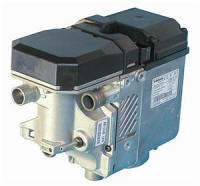
 |
Similarly, I researched and specified the hydraulic
steering system for the boat. I chose hydraulic
steering because I thought it made the most sense for
this application, and also largely because it would
allow me to install an outstanding and convenient
hydraulic autopilot, which was really the driving force
behind the decision. I selected a Seastar system
from Teleflex marine, and ordered the requisite helm
unit, heavy-duty brass steering cylinder, Kevlar
hydraulic hoses, and a few related components required
for the installation of the steering and eventual
autopilot. |
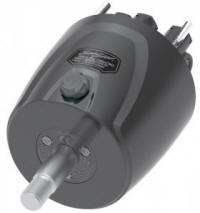 |
 |
The steering research necessarily led me into the realm
of autopilot research, which, in turn, led me
necessarily into the whole new world of navigation
electronics. Though I was aware of the basic
advances in technology, I'd not actually shopped for
electronics for more than 10 years, since outfitting my
last boat, and there was a substantial learning curve.
I'd purposely not looked much at the advances over the
years, as things were changing so fast, and at the time
I didn't want to tempt myself with an upgrade to my old
boat that I didn't need. But all along, I was
looking forward to the chance to outfit the new boat
with the state of the art when the time came.
Since the networking of electronics was now de
rigueur, my inclination was to stick with a single
brand for all aspects of my system; even though various
brands can also be interconnected, I preferred the idea
of an integrated system from one company, whether it
mattered or not. As amazing as the technology was,
I wasn't a techno geek, and in the end I wanted reliable
function over form. I was willing to buy the best, but
wouldn't spend for features I didn't need or want
either.
This was fun, if overwhelming, and I had a lot to learn.
I had pretty much narrowed down my autopilot choice to
Simrad, and this company had other offerings that looked
good to me as well, particularly the brand-new broadband
radar system, which I'd never heard of before stumbling
upon it during autopilot research.
In any event, I made no decisions, and had a long way to
go to decipher the various choices and, eventually,
decide upon the overall system that made the most sense
for this boat. One problem with integrated
systems is that one can't make one choice without it
affecting everything else, so in order to choose an
autopilot I also had to choose the rest of the
system--or at least it was much smarter to do so.
What I did get out of my research was the salient
information about the general compatibility of various
manufacturers' hydraulic autopilot pumps and the
Teleflex steering system I selected, and for the moment
this was enough.
In between all of this, as time allowed, I managed to
get some real work done too. Over a few days, I
applied several additional coats of varnish to the plate
rack and wire chase panel, ending with a coat of
rubbed-effect satin varnish. |
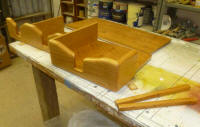 |
Also, I applied two finish coats of white enamel to the
engine room plywood panels. |
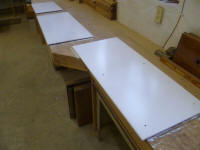 |
The multiple fuel and water tanks on board would require
manifolds to select which tank to draw from. To
this end, I ordered some machined aluminum manifold
blocks, into which I installed brass ball valves and
other fittings to select and route fuel supply and
return, as well as water supply from the three tanks.
Earlier, I'd found some pre-assembled fuel manifolds
online, but was able to source individual parts for
significantly less cost.
I assembled the three manifolds one afternoon, taking
about 45 minutes to complete the process. To give
more room for the valves, I ordered manifolds with
additional outlets, so I could better space the valves;
I filled the unneeded holes with threaded plugs.
In these photos, the hose barbs and end fittings (inlet
and a plug at the opposite end) are only loosely
threaded into position for show, since I'd have to lay
out the manifolds' installation before determining from
which direction the inlet would come, for example, and
whether I needed any 90° fittings for various hoses.
I thought those manifolds were really cool, and would
give me years of pleasure. |
Fuel Supply and Return Manifolds
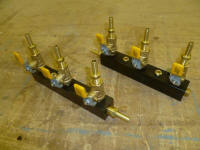 |
Potable Water Manifold
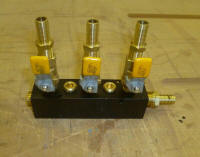 |
| |
Total Time Today: 2.75 hours
(plus undocumented research time) |
<
Previous |
Next > |
|
|









